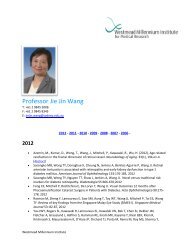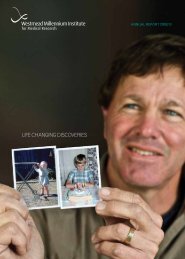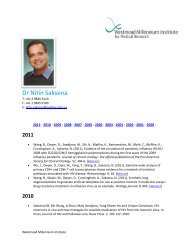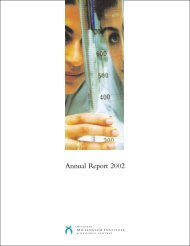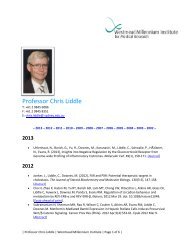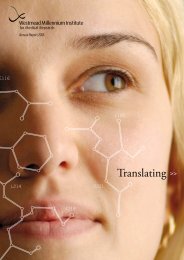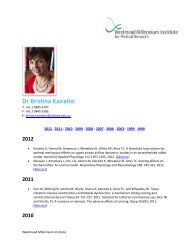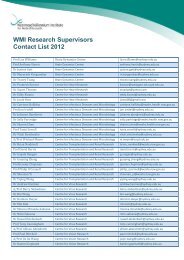Annual Report 2005 - Westmead Millennium Institute
Annual Report 2005 - Westmead Millennium Institute
Annual Report 2005 - Westmead Millennium Institute
You also want an ePaper? Increase the reach of your titles
YUMPU automatically turns print PDFs into web optimized ePapers that Google loves.
Centre for Heart ResearchPrevention of sudden deathSudden death is usually caused by an abnormal heart rhythmproduced by a problem in the ventricles of the heart. Ventriculartachycardia and ventricular fibrillation are the two major heartrhythms responsible for sudden death and both are the subject ofresearch currently being performed by this group. Some abnormalheart rhythms can be treated by minimally invasive procedures inwhich abnormal electrical pathways in the heart are ablated.Attempts to cure ventricular tachycardia using percutaneouscatheters have been hampered by the inadequacies of conventionalmapping and ablation techniques. Researchers in this group havedesigned a catheter that could create a deeper ablation lesion thanis possible with maximal conventional therapy. A prototype catheterwas constructed in-house and tested using an ex-vivo ovine model.The prototype catheter was shown to create lesions that weresignificantly deeper and just as wide as lesions created withconventional catheters. Efforts are also being directed at improvedmapping procedures for determining the underlying mechanismsof ventricular arrhythmias and facilitating curative therapy. Thiswork gained additional support in <strong>2005</strong> by the awarding of aNHMRC Project Grant.Ventricular fibrillation is also a cause of sudden death andcommonly occurs at the time of a heart attack. The mechanismof this electrical problem that stops the heart beating effectively isincompletely understood. Researchers are studying the behaviourof electrical currents in the heart during ventricular fibrillation to tryand detect patterns that may allow new treatments for thisimportant abnormal heart rhythm.Atrial fibrillationAtrial fibrillation results in chaotic beating of the heart and is the mostcommon cause of abnormal heart rhythm. It is due to abnormalelectrical activation of the upper part of the heart called the atria.Recently a curative minimally invasive treatment has been developedfor atrial fibrillation. There are large groups of patients for whom thistreatment is not effective. The Cardiology Research Centre isperforming basic and applied studies to improve the safety andefficacy of treatment for atrial fibrillation. These include studies ofopen heart and minimally invasive techniques for cure of atrialfibrillation.Alternative energy sources for treatment ofabnormal heart rhythmsPercutaneous, minimally invasive techniques to treat abnormal heartrhythms require delivery of alternating electrical current. Thistechnique is used to heat abnormal parts of the heart and interruptshort circuits responsible for the rhythm problems. There areimportant limitations to this technique. In an attempt to createdevices that overcome some of the current difficulties with existingtechnology, cardiology researchers are investigating alternativeenergy sources such as microwaves. This ARC funded project is acollaboration with the University of Technology.Imaging and cardiac functionEchocardiography uses ultrasound waves to study cardiac structureand function. Ultrasound is a safe and effective way to visualize theheart. Researchers have used echocardiography to monitor andevaluate atrial size and function after procedures to treat atrialfibrillation. New techniques have been used to develop noninvasiveparameters of total and segmental atrial function. Two and threedimensional atrial volume estimation has also been performed toevaluate atrial remodeling after restoration of normal rhythm. Theseresults may help to alter techniques and treatments currently usedfor atrial fibrillation. This work is supported by funding from theNational Heart Foundation.



